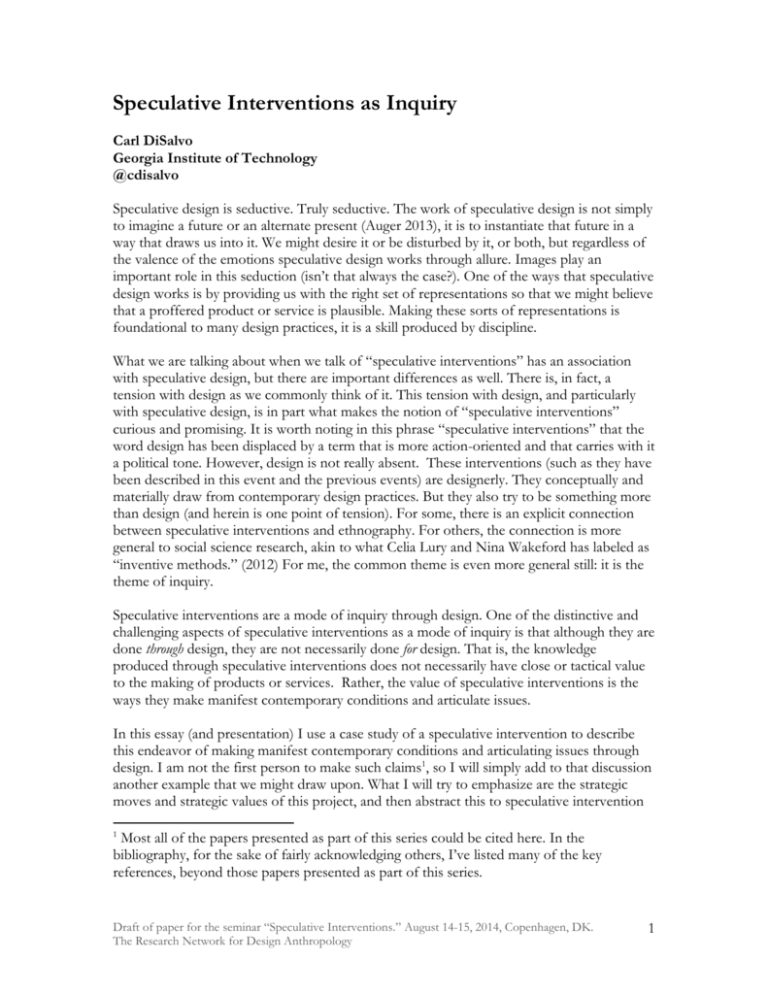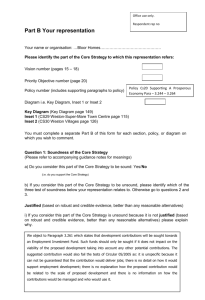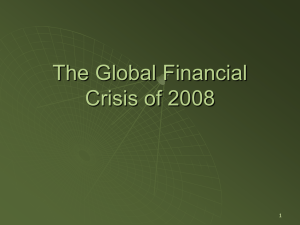Speculative Interventions as Inquiry
advertisement

Speculative Interventions as Inquiry Carl DiSalvo Georgia Institute of Technology @cdisalvo Speculative design is seductive. Truly seductive. The work of speculative design is not simply to imagine a future or an alternate present (Auger 2013), it is to instantiate that future in a way that draws us into it. We might desire it or be disturbed by it, or both, but regardless of the valence of the emotions speculative design works through allure. Images play an important role in this seduction (isn’t that always the case?). One of the ways that speculative design works is by providing us with the right set of representations so that we might believe that a proffered product or service is plausible. Making these sorts of representations is foundational to many design practices, it is a skill produced by discipline. What we are talking about when we talk of “speculative interventions” has an association with speculative design, but there are important differences as well. There is, in fact, a tension with design as we commonly think of it. This tension with design, and particularly with speculative design, is in part what makes the notion of “speculative interventions” curious and promising. It is worth noting in this phrase “speculative interventions” that the word design has been displaced by a term that is more action-oriented and that carries with it a political tone. However, design is not really absent. These interventions (such as they have been described in this event and the previous events) are designerly. They conceptually and materially draw from contemporary design practices. But they also try to be something more than design (and herein is one point of tension). For some, there is an explicit connection between speculative interventions and ethnography. For others, the connection is more general to social science research, akin to what Celia Lury and Nina Wakeford has labeled as “inventive methods.” (2012) For me, the common theme is even more general still: it is the theme of inquiry. Speculative interventions are a mode of inquiry through design. One of the distinctive and challenging aspects of speculative interventions as a mode of inquiry is that although they are done through design, they are not necessarily done for design. That is, the knowledge produced through speculative interventions does not necessarily have close or tactical value to the making of products or services. Rather, the value of speculative interventions is the ways they make manifest contemporary conditions and articulate issues. In this essay (and presentation) I use a case study of a speculative intervention to describe this endeavor of making manifest contemporary conditions and articulating issues through design. I am not the first person to make such claims1, so I will simply add to that discussion another example that we might draw upon. What I will try to emphasize are the strategic moves and strategic values of this project, and then abstract this to speculative intervention 1 Most all of the papers presented as part of this series could be cited here. In the bibliography, for the sake of fairly acknowledging others, I’ve listed many of the key references, beyond those papers presented as part of this series. Draft of paper for the seminar “Speculative Interventions.” August 14-15, 2014, Copenhagen, DK. The Research Network for Design Anthropology 1 more generally. Perhaps none of this will be provocative, but I want to show the potential value of this practice to give significance to my concluding thoughts: the problem is that we (a community of designers, design researchers, and social scientists) have yet to adequately explain and demonstrate the value of this inquiry to broader publics. Foraging This case study of speculative intervention involves foraging. Understanding a bit about foraging is important for explaining the moves and values of speculative intervention as a mode of inquiry through design. Foraging is the activity of collecting fruits and vegetables from sites other than farms or orchards. Examples include apples from trees planted in parks or yards and greens gathered from abandoned lots or along the roadway. Although these fruits and vegetables were not intended for consumption, they are still valuable food stuffs. They may be consumed by those who collect them, or they may be sold to restaurants or at markets, or they may be given to food banks or other social service providers to augment the food provisioned to those in need. Foraging takes place at many scales. In part, the scale is dependent upon the purpose. When the purpose is to provide food for ones’ self (whether that is out of need or desire), foraging is low intensity activity. When for sale, whether to markets or restaurants, foraging may become more intensive in order to procure a yield that will profit commensurate to the time and effort put into the work. And the effort is significant, precisely because the fruit and vegetables have not be planted and tended to for ease of cultivation. One has to locate the fruits and vegetables, monitor their growth, and then collect them. All of these activities are compounded in difficulty depending on the location of trees and plants and the fact that the trees and plants are often spread across some distance—not co-located in a single field or plot. Foraging to provide to food banks or other social service providers often occurs at an even larger scale. To substantively augment food security and contribute to local resilience requires significant amounts. This scale further exacerbates the challenges of foraging. One aspect of this challenge is locating fruits and vegetables. This is time consuming to be sure. But, it would seem, there is an abundance of fruits and vegetables available in many cities. The problem is not a lack of forage-able food. A greater challenge is managing the volunteers needed to collect and distribute the fruits and vegetables. And part of that management is an issue of timing: when to organize a pick? The answer to that question depends upon the fruit or vegetable itself. In fields, plots, and orchards, monitoring fruits and vegetables is relatively easy to do. As is monitoring an individual tree or cluster of bushes or a row of greens in a garden. But keeping track of 100 apples trees across a city or four-dozen blueberry bushes in six different parks—this presents a significant challenge. So, whatever poetic notions might be ascribed to foraging—and this is often the case, particularly in the media—at scale foraging becomes a logistics problem. Drones for Foragers Over the past year we have been working with a group of foragers in Atlanta, GA (USA) to explore, from a research-through-design approach, how DIY and hobbyist drones might be used in support of their activities. Specifically of interest was whether, and if so how, drones Draft of paper for the seminar “Speculative Interventions.” August 14-15, 2014, Copenhagen, DK. The Research Network for Design Anthropology 2 might be used to assist in fruit spotting and monitoring—that is, locating fruit available to forage and then monitoring the progress of the fruit to ripeness. The drones, potentially, offer a platform for remote and automated viewing. In some cases the desire for this is a matter of time. As previously mentioned, monitoring dozens of trees across a city is a time consuming affair. In other cases, it is a matter of convenience and safety—for instance when trees are located along a busy roadway it would be easier to scout the fruit via drone from across the street. This is not science fiction. DIY and hobbyist drones have the basic capacity to achieve some of these ends. A relatively inexpensive hobbyist drone platform can stream video and take photographs using a smart phone or tablet as a controller. In some models, hobbyist drones can be outfitted with GPS and directed to fly paths set through simple map-based interfaces. More expensive DIY drones have expanded auto-pilot capabilities with greater fidelity GPS, as well as the capacity for more sophisticated imaging and sensing. The starting point of this speculation invention is thus dually grounded in the practices of foraging and the capacities of drone systems. In addition, the use of drones in agriculture is steadily increasing—through perhaps not yet common, it certainly is no longer an oddity. Drones are part of a larger push towards socalled precision agriculture, which strives to provide a wealth and variety of data throughout agricultural processes in order to enable better decision making, and ultimately, better yield. Exploring drones for foraging is a bit of an ironic endeavor, then, because as has been alluded to foraging is anything but precise. Let’s pause to call attention to this. The embrace of and execution on this irony is a strategic move of speculative intervention and a basis of inquiry. There is very little research into technologies for small-scale agriculture. There is even less research into technologies for socalled alternative agricultures. Pursuing the questions of drones for foraging is, in part, a calculated and inventive move for opening a practice to design inquiry, to attend to a practice that is otherwise not so attended too. The irony also signals inquiry because inquiry is often grounded in paradox. It is the perceived inconsistently of a situation, and the desire to engage, understand, express, and appreciate (if not resolve) the conflicting aspects a situation that undergird and motivate the investigation and experimentation that comprise inquiry. So, what we get from this design inquiry is insight into the interplay between the conditions of foraging and the conditions of contemporary agriculture technologies, and through that, an articulation of the needs and desires of foragers as they are and might be instantiated through the possible (speculative) re-design of agriculture technologies. By intervening, we also get insight into new modes and practices of economics, and perhaps even of civics. Foraging comprises a kind of labor and exchange that operates in parallel to tradition modes of labor and exchange. It is not counter to capitalism, but rather it is a different mode of capitalism, what is sometimes referred to as post-capitalism (GibsonGraham 1996, 2006). In a similar manner, foraging as food provisioning can be considered as different mode of civics: one that enables service provisioning and public care through channels that operate in parallel to formal municipal and non-profit organizations. Of course supporting work is a long-standing concern of design, and engagement with labor (both in Draft of paper for the seminar “Speculative Interventions.” August 14-15, 2014, Copenhagen, DK. The Research Network for Design Anthropology 3 theory and practice) has been a particular concern of participatory design. Civics is a topic of renewed interest, particularly in regards to the potential roles of design in government and non-governmental organizations. Similar to the distribution of research and design between industrial agriculture and small-scale or alternative agricultures, the majority of design concerned with economics, labor, and civics has focused on the traditional modes of those practices, while alternative economies and civics have received less attention. So not only does this speculative intervention open up a space for design inquiry with regard to agricultural technologies, it also does so with regard to the conditions of agriculture: the role of the market economy and the responsibilities of the state. But what does this speculative intervention look like, and what is its association to design? In many respects, it does not appear all that different from common practices of participatory design or co-design. We spend time together. We participate in the practices of foraging. We develop use cases and scenarios and prototypes. What makes this work distinctive is the subject matter and the purpose. The subject matter is, as just discussed, ironic, and it is also curious. Flying drones in public parks and along city streets attracts attention. So does stopping along a sidewalk to pick mulberries or apples. Each of these domains is, in itself, somewhat strange and fanciful. Combined together they become provocative. But the design work, in terms of the materialities of design practice, remain fairly mundane: images, diagrams, wireframes, video. It is the purpose and outcomes of this endeavor that are meaningfully different. Speculative Interventions: Through design but not for design The outcome of design inquiry is often understanding or knowledge to inform design. This is certainly the case with common forms of design research that occur in professional settings. We investigate a domain so that we might better design for that domain. The value of such design research is usually in direct relation to the extent to which it informs design. But that is not the case with these speculative interventions. With these endeavors the connection to design is present, but it is less direct, and it requires us to consider an expanded field of design. Let’s consider a proposition: The purpose of speculative interventions is not to better the design of products or services in the here and now. The purpose of speculative interventions is to discover the conditions of design and articulate the issues of those conditions. This knowledge may have application to design of products and services, but it need not. Its value not determined by any such application. If it does have value to the design of products and services, that value is more likely to be strategic rather than tactical and with an extended horizon. But it need not have such value. It is enough to simply produce knowledge. Is this provocative? It depends upon our understanding of design. To embrace this position requires that we accept design as a mode knowledge production, as an epistemic practice, that does not require an application to design to give value to that practice. It is enough just to use design to produce knowledge about a condition or issue—one does not have to Draft of paper for the seminar “Speculative Interventions.” August 14-15, 2014, Copenhagen, DK. The Research Network for Design Anthropology 4 design toward that condition or issue for this knowledge, and the practice of producing it, to be legitimate. What would be the value of this knowledge if not applied to design? We could imagine it as simply knowledge in its own right, contributing to an understanding of our made-world and the processes by which that made-world comes into being and is expressed. Just an anthropology, and by extension ethnography, transitions from being a device of imperialism to constituting a field of study and corpus of knowledge on “culture”, so might we imagine a similar transition for design. Another option would be to imagine speculative interventions as a methodology for the production of knowledge useful for other domains of practice, ranging from engineering to business strategy to policy. Returning to drones for foraging: though it is plausible that we might use drones to support urban foraging, it is not likely. In part what we learned through out speculative interventions were the myriad reasons why, in the near term, it is not likely. Certainly we also gain some insights that might be used to inform the design of drone control software or imaging and visualization services or even form factor of the drone. But the real value seems to be in the ongoing work of encountering and learning of and coming to understand the particulars of foraging as a mode of economics and civics together with how the made-world works in various ways to support or thwart those practices of economics and civics. For instance, policy in the United States for drones is extremely restrictive, particularly for individuals or organizations involved in commerce. But foraging does not fall under the definition of commerce, so it is exempt from those restrictions. What we discover, then, is how policy structures may be accidentally amenable to post-capital practices because of the in-betweenness of these practices. This suggests there might be other opportunities in policy to exploit in support of post-capitalistic economics. Or as another example, through experiments in developing a service model for drones for foraging, we were able to identify alternative modes of fruit spotting and monitoring that might leverage existing practices and technologies. For instance, rather than deploying an autonomous vehicle, the forager organization might enroll commuter cyclist to use their mobile devices to capture images of fruit as part of an open data collection program. This would require no new design per se. With these two (admittedly simple and brief) examples we can begin to see how the research through design might have value beyond design: how speculative interventions as a designerly research practice might serve more than the development of products and services. In one example, we get a glimpse of how the speculative interventions might illuminate strategic economic opportunities, in the other example, how speculative interventions might lead to insights in process. By Way of Conclusion, A Conundrum We are left with a conundrum, a challenge. Let’s assume we agree with the claim that speculative interventions are a kind of inquiry that produces knowledge about the conditions of design and articulates issues. For whom is this knowledge valuable and how is it circulated? We need to answer these questions. In the preceding examples we might say the insight about process is valuable to the foraging group and the knowledge about policy could be of value to a broader public of both activists Draft of paper for the seminar “Speculative Interventions.” August 14-15, 2014, Copenhagen, DK. The Research Network for Design Anthropology 5 and scholars. It is easy to imagine how we might share the insight about process to the foragers. Assuming the work was conducted collaboratively, this knowledge transfer could take place through any number of familiar formats. In this scenario, we (the design researchers conducting the speculative interventions) become a sort of research studio for our partner, providing insights gleaned through our work. This general model is not so uncommon—what’s uncommon is to consider design as a means of such research, to consider design research as such a service to a community or organization that provides general knowledge, not necessarily applied to design. The other example—the insights about possible opportunities for post-capital economics that might be accidentally afforded by policy—is more difficult. How would we, as design researchers, share this knowledge? What forum is there? What form would it take? For instance, should this knowledge enter into some sort of exchange with other research on post-capitalism? Should this knowledge enter into some sort of exchange with other research on economic or innovation policy? If so, what is the pathway to achieve that? I do not have an answer to these questions. But I believe that trying to answer these questions is important. If we can find the means to communicate the potential value of design as a research practice that goes beyond simply informing product and service development then we have an opportunity to greatly expand the scope of design as field. Many of us seem to believe this value exists. Moreover, many of us seem to believe that these practices of speculation are of particular value and interest—there is something about speculation that seems both appropriate and compelling as a basis for an expanded field of design research. But it is not clear if or how this knowledge moves beyond design to contribute to the broader publics of scholars and decisions makers, for whom these practices of speculative intervention, as exciting as they are, may be unknown. References Auger, J. (2013). Speculative Design: Crafting the speculation. Digital Creativity, 24(1), 11-35. Gibson-Graham, J. K. (2006). “The” End of Capitalism (as We Knew It): A Feminist Critique of Political Economy; with a New Introduction. U of Minnesota Press. Gibson-Graham, J. K. (2006). A postcapitalist politics. U of Minnesota Press. Lury, C., & Wakeford, N. (Eds.). (2012). Inventive methods: The happening of the social. Routledge. Draft of paper for the seminar “Speculative Interventions.” August 14-15, 2014, Copenhagen, DK. The Research Network for Design Anthropology 6







